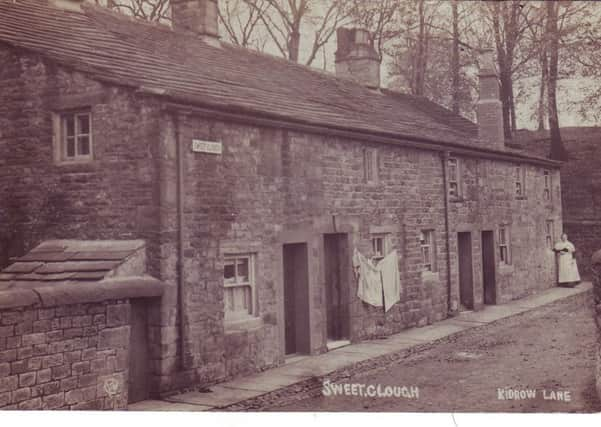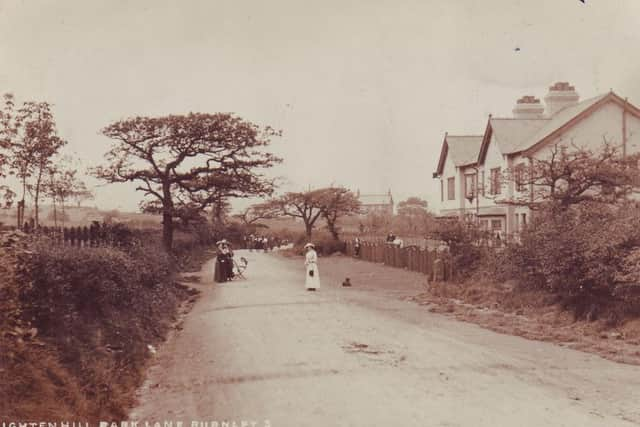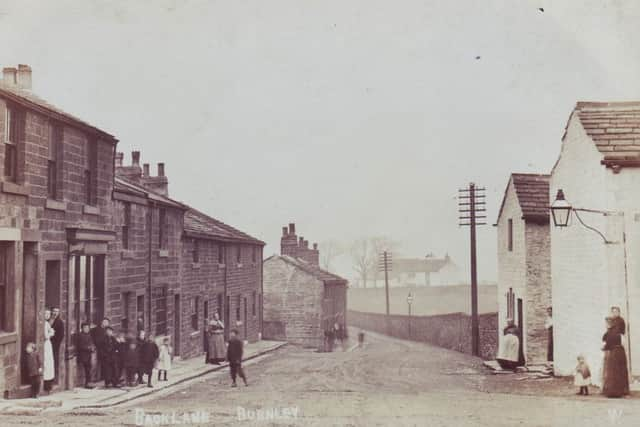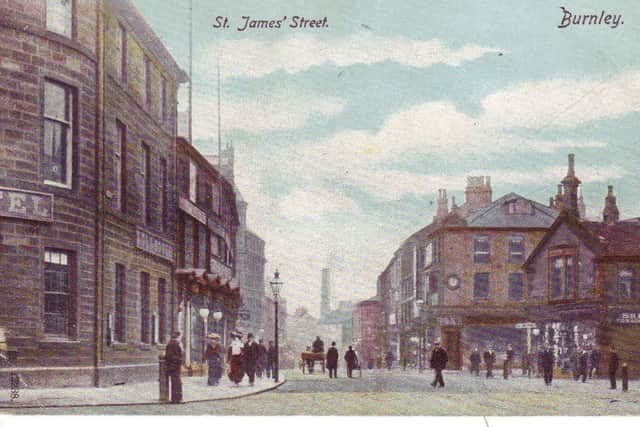‘Clitheroe’ links to Kiddrow Lane, Burnley?


I do not think I could be persuaded to agree with that, but I have decided to offer you four images which have no real connection except they were taken in, and around, Burnley. The photos are all postcards taken from the Briercliffe Society’s Postcard Collection. Some you will have not seen before as they are recent additions, some coming from the Burnley Express and others acquired by the society at postcard fairs or donated to the society by those who think the work of the society, in preserving the best of our past, should be supported.
The first image is of “Ightenhill Park Lane, Burnley” and a number, 5, is added to that description. However, this part of Ightenhill Park Lane is not in entirely in Burnley. It is in what was then known as the Parish of Ightenhill Park, a reference not to the present municipal park, which dates to 1912, but to the fact Ightenhill was once a piece of land set aside for hunting. Almost all the present Ightenhill used to be a place where the Lord of the Manor, and his friends, could spend their time in what became the gentlemanly pursuit of deer.
Advertisement
Hide AdAdvertisement
Hide AdThis picture was taken about 1905. The fashions worn by those in the picture confirm this but, surprisingly, perhaps, the best clue is afforded by the boy seen to the left of centre. You will have to get your magnifying glass out to see him but he is standing in front two women, both of whom are wearing fashionably large hats. They are pushing a perambulator (a pram, as we would call it) in which there is a young girl sitting.


The boy is wearing the giveaway clue, a large white collar. These were not popular for all that long, especially for boys. Their mothers had to wash and scrub their husband’s collars, an unforgiving task at the best of times, and soon realised that doing the same for their sons was something they could do without.
There is another reason why I know this card was taken about that time. The clue is the description of where the photo was taken at the bottom, left of the card. These words are not printed, they were written by hand and there was only one person in Burnley who could manage such neat work. I say this as each letter has to be written “back to front” so they appeared the right way round when they were printed. Quite a skill. Others who attempted it often got the letter “S” the wrong way round and, often not being highly educated, did not notice until it was too late.
So who was the photographer? It was Richard Broughton, a local man, who, from c1902 to c1908, had a business, as a photographer (and later a photographer and confectioner) in Woodbine Road. This was in the area of Ightenhill but, by 1911, Richard had moved to 352 Padiham Road, which, in 1914, was home of Herbert Harling of the firm of Harling & Todd, Burnley loom makers.
Advertisement
Hide AdAdvertisement
Hide AdIn the back ground the farm buildings are those of Ightenhill Farm and the three houses, right, included Easton, which, I think is 61 Ightenhill Park Lane.


The next picture, number 2, which, according to the description on the card, is of “Back Lane, Burnley”. But, again, this is not quite right as Back Lane was in Habergham Eaves, not Burnley.
In the 1895 Directory there are only a few entries for Back Lane. They comprise the famous National School, the Griffin Hotel, four shopkeepers, one coal dealer and a farmer, but you can see that, though there appears to be only one shop in the image we publish, there are more houses than the Directory had given credit for.
The 1914 Directory entry for Back Lane, merely refers the reader to Rossendale Road. This is because Back Lane was absorbed into Rossendale Road when that was completed from the cross roads on Accrington Road to Manchester Road.
Advertisement
Hide AdAdvertisement
Hide AdI am particularly pleased to have this image. It shows Back Lane as it once was, an unmade country lane, this part of it a community in its own right. The first row of cottages, left, are still there but the short row beyond them, and the whitewashed properties, right, have gone. They stood somewhere near the junction of Back Lane with Coal Clough Lane.


In the background you can see small white-washed farm buildings which may have been Cherry Fold Farm.
The third picture is of “Sweetclough, Kiddrow Lane”, so we know where they were. Those of you who know Kiddrow Lane, which is off Padiham Road, will know there is still a property which is known as Sweet Clough but the buildings you see in the picture are not the ones we see today.
To my mind, the Kiddow Lane area is one of the more interesting parts of Burnley and I have thought, time and again, I should research it more thoroughly. Unfortunately, I have not done so but, occasionally, I spot something that tells me a little about the area.
Advertisement
Hide AdAdvertisement
Hide AdOne of these things was about the name itself which must be one of the most unusual street names in Burnley. I “googled” Kiddrow, skimming through 10 pages of information. However, what I read referred only to Burnley’s Kiddrow Lane. That got me thinking what “Kiddrow” might have been? What was the Kiddrow that the lane gave access to?
When looking up place names beginning “Kid”, there was little that seemed to apply to Burnley. It was suggested “Kid” is derived from Cydda, a personal name, as in Kidderminster, Kiddington and Kidland in Worcestershire, Oxfordshire and Northumberland respectively.
Not satisfied, I recalled seeing, when doing research in Clitheroe, there was once a farm, or croft, in this area of Burnley. It, and the land around it, was up for sale but the name was not exactly Kiddrow or Clitheroe. Mr Bennett, in his History of Burnley, has it as “Kitheroe”, so I decided to look up “Clitheroe” in the “Oxford Dictionary of Place-Names” to see whether there were any clues there.
The first mention of Clitheroe is as “Cliderhou” in 1102 and there is “Clitherow” in 1124. The last syllable, in the 1102 spelling, means “hill” in Old Norse, the language of the Vikings. “Hou” is similar to “how” which means “hill” and the 1124 spelling “row” looks, to me to be phonetic. It, too, must mean “hill”.
Advertisement
Hide AdAdvertisement
Hide AdThe first part of the word, “Clider”, in 1102, refers to the song thrush, the “clider bird” as it was sometimes known. Alternatively, I have heard the swallow has also been referred to as the “clider bird”. It follows, then, that Clitheroe, and therefore Kitheroe, must mean “song thrush hill” or “swallow hill”.
Why it was that Burnley, or should I say Habergham Eaves, got its own little Kitheroe? I have to admit I do not know. The name, however, could be transposed, meaning someone took it with them when they moved from Clitheroe to the Burnley area. After all, this probably happened with Gannow and Saunder Bank, the originals of which are also in the Ribble Valley.
There is also the possibility the part of Burnley which contained Kitheroe may have had a connection with Clitheroe. Kiddrow Lane is not far from the manor house at Ightenhill which had well-established connections with Clitheroe Castle from at least the later 12th Century.
Alternatively, and more simply, it could be there was a hill in the area which became notable for swallows or song thrushes. Why not? Clitheroe did not have a monopoly on either bird.
Advertisement
Hide AdAdvertisement
Hide AdLastly, on this card, the stone built cottages look as if they might, originally, have provided homes for workers at Lowerhouse Mills or the calico printers also located at Lowerhouse. Otherwise, they might have been handloom weavers’ cottages, though the windows do not look large enough for that.
The last picture is one with which many of you will be familiar. Over the years I have featured many images of St James’s Street in this column, but this is different. The scene depicted, with the Bull Hotel, left, and St James’s Street looking down to Curzon Street and Hammerton Street, dominating the rest of the image, is hardly new to, I would think, any of you.
What is new is that we know when this card was written, from where it was addressed (and by whom) and to whom it was sent. Surprisingly, this card turns out to be a business card issued, and written, by hand, by J.A. Spencer of 11 Coal Street, Burnley on 18th April, 1904. The card is stamped with a green half penny stamp and was posted at 7-45pm that day.
The recipient was to have been Mrs Mitton, Confectioner, Foxhall Road, Blackpool and the message reads, “Dear Madam, I hope to call on you on Thursday, when your orders will be esteemed, Yours, J.A. Spencer”.